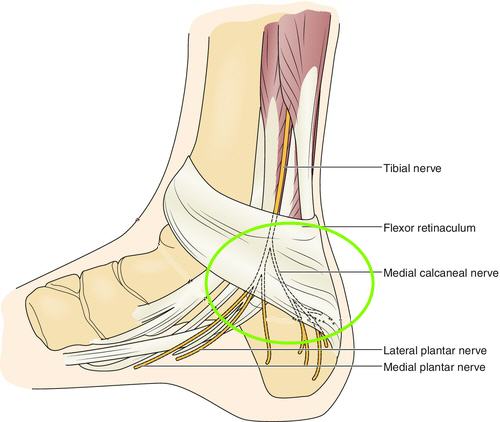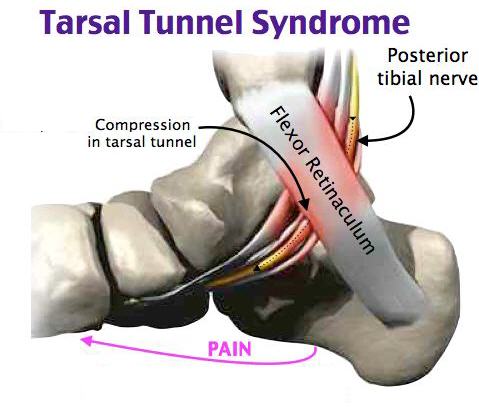As I mentioned in Part 1 of this 3 part series, heel pain can feel like plantar fasciitis, but may not be caused by it. Treating a heel related condition as plantar fasciitis when it isn’t can make the condition worse.
In this 2nd part, I’ll show you a few common conditions involving nerves that have heel pain similar to plantar fasciitis as a symptom.
In nerve entrapment syndromes, pressure is placed on a nerve by some other body part, like a bone, muscle, or cyst. The nerve sends out a pain signal in response to that pressure. In your foot, the most common nerve “pinches” or “entrapments” are:
- Medial Calcaneal Nerve Entrapment
- Medial Plantar Nerve Entrapment
- Lateral Plantar Nerve Entrapment
- Tarsal Tunnel Syndrome
- Baxter’s Nerve Entrapment
As you can see in the image above (click on it to enlarge), the tibial nerve splits into medial and plantar nerves underneath the retinaculum, which is a fascia subject to tearing and trauma, just like the plantar fascia
There are sometimes differences in care required for these different nerve entrapment locations, though rest, ice, use of NSAIDs if possible, supportive shoes and need for temporary supports, and then functional orthotics, are commonly required to properly treat nerve entrapment syndromes.
Medial Calcaneal Nerve Entrapment
The medial calcaneal nerve is a branch of the tibial nerve on the inside of your ankle. Its symptoms are often confused with those of plantar fasciitis and tarsal tunnel syndrome. Treatment is different than that for plantar fasciitis, so getting an accurate diagnosis is key to quick recovery.
Medial Calcaneal Nerve Entrapment Symptoms
- Pain and burning felt under your medial (inside) ankle bone, and in your heel
- Pain starts on the medial side of your heel and travels towards the center
- Activity makes it worse
- Tinel’s sign is positive
Medial Calcaneal Nerve Entrapment Self-Treatment
- Rest
- Avoid activities that lead to pain
- NSAIDs as you can, for pain relief
- Use cold compresses
- Use inexpensive arch supports.
You may need to immobilize your foot.
If you don’t feel much better in a week or so, come see me.
Medial Plantar Nerve Entrapment
The medial plantar nerve runs along the inside central part of your arch. Just like most of the other nerves I talk about in this post, the medial plantar nerve branches off the tibial nerve within the tarsal tunnel underneath the retinaculum. This is where nerve entrapment in general commonly occurs. And so it is with the medial plantar nerve.
Entrapment of the medial plantar nerve is also called, “Jogger’s Foot”.
Medial Plantar Nerve Entrapment Symptoms
- Radiating tingling, numbeness or burning pain from your arch to your big toe
- Burning pain under your heel, worsening at night.
- Acute tenderness where the nerve is trapped (the tarsal tunnel)
- Pain that gets worse with stretching
- Increase in pain when standing on tip-toe
Medial Plantar Nerve Entrapment
The medial plantar nerve runs along the inside central part of your arch. Just like most of the other nerves I talk about in this post, the medial plantar nerve branches off the tibial nerve within the tarsal tunnel underneath the retinaculum. This is where nerve entrapment in general commonly occurs. And so it is with the medial plantar nerve.
Entrapment of the medial plantar nerve is also called, “Jogger’s Foot”.
Sports that involve lots of running, having a history of ankle sprains, tight-fitting shoes, stiff big toes, diabetes, and thyroid disorders increase your risk of having this kind of nerve entrapment.
Medial Plantar Nerve Entrapment Symptoms
- Radiating tingling, numbeness or burning pain from your arch to your big toe
- Burning pain under your heel, worsening at night.
- Acute tenderness where the nerve is trapped (the tarsal tunnel)
- Pain that gets worse with stretching
- Increase in pain when standing on tip-toe
Sometimes the only pain you have is during or just after running.
Medial Plantar Nerve Entrapment Self-Treatment
- Rest from any activity that increases your symptoms (it may not releivepain, but is needed to allow the nerve to calm down a bit)
- NSAIDs as you can, for pain relief
- Try some Inexpensive arch supports, with not too much arch.
- Wear different, more supportive, footwear.
Sometimes, medial plantar nerve entrapment will go away on its own. More likely, it will go away with non-surgical care. Non-surgical care of nerve entrapments often require use of a functional orthotic.
Occasionally surgery is needed. If self-treatment isn’t making your pain decrease significantly in a week or two, come see me.
Lateral Plantar Nerve Entrapment
The branch of the posterior tibial nerve that runs along the outside of the bottom of the foot is called the lateral plantar nerve. Pressure on this nerve causes pain that can radiate to the lower part of your heel and ankle. Extensive or continuous activity tends to worsen symptoms.
Lateral Plantar Nerve Entrapment Symptoms
- Radiating pain to the heel and ankle area.
- Burning pain worsening at night.
- Acute tenderness where the nerve is trapped (the tarsal tunnel)
Lateral Plantar Nerve Entrapment Self-Treatment
- Rest.
- NSAIDs as you can, for pain relief
- Inexpensive arch supports
- Wearing different, more supportive, footwear may help.
Again, if your pain isn’t much less in a week or so, come see me.
Baxter’s Nerve Entrapment
Probably the most common nerve entrapment symptom confused with plantar fasciitis is when the “inferior calcaneal nerve” (aka “Baxter’s Nerve”) that runs along the bottom of the heel is pinched. Clinical symptoms of Baxter’s Entrapment and plantar fasciitis can be virtually identical.
Baxter’s neuropathy may actually account for up to 20% of heel pain cases, although it is frequently misdiagnosed. If it is misdiagnosed as plantar fasciitis then traditional plantar fasciitis treatment could be ineffective, or actually make the condition worse.
Baxter’s Nerve Entrapment Symptoms
Symptoms of Baxter’s Nerve Entrapment include:
- No morning pain but pain increasing as the day goes on
- Tingling, tickling, pricking, numbness or burning sensation across the outside bottom of your heel
- Pain if you press on the inside bottom of your heel
Baxter’s Nerve Entrapment Treatment
This one’s for doctors only. If you have any of these symptoms, please come see me.
Tarsal Tunnel Syndrome
Tarsal tunnel syndrome is caused by compression of the tibial nerve as it passes the inside of the ankle.
This can feel like a burning or tingling sensation in the heel area and within the arch of the foot, with occasional loss of sensation on the bottom of the foot.
The tibial nerve gets entrapped at this location because there’s a mass of nerves, ligaments, and muscles that all pass through a skeletal structure called the tarsal tunnel. It’s similar to the carpal tunnel of the wrist.
Entrapping the posterior tibial nerve can result from any condition that puts compression on it, including
- flat feet or fallen arches,
- overuse,
- prolonged standing,
- excessive walking or exercising,
- swollen tendon, ganglion cyst, varicose vein,
- sprain or fracture,
- rheumatoid arthritis,
- diabetes.
Tarsal Tunnel Syndrome Symptoms
Symptoms associated with tarsal tunnel syndrome include
- pain, especially shooting pain,
- numbness,
- tingling, burning or “electric shock” sensation in the heel
- burning pain,
- shooting pain,
- sharp pain,
- aching.
It can cause heel pain, ankle pain, bottom of the foot pain and even toe pain.
Patients often complain of excruciating heel pain, and sometimes incorrectly self-diagnose this problem as plantar fasciitis.
Tinel’s sign is one test doctors use to help confirm a diagnosis of tarsal tunnel syndrome. It’s positive when lightly tapping over the nerve gives you a sensation of tingling or ‘pins and needles’ along the distribution of the nerve (the paths it takes until it ends).
Tarsal Tunnel Syndrome Self-Treatment Not Recommended
Self-treatment for tarsal tunnel syndrome is not recommended. If you are determined to try (please don’t), do this for 2 weeks, and if you aren’t 100% better, come see me:
- Take an anti-inflammatory if you can
- Wear a stable shoe that prevents the heel from rolling in
- Wear an arch support in your shoes (not an expensive one, just a solid, not gel-like one)
- Don’t go barefoot at all, even in the house.










